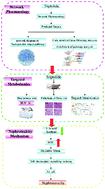当前位置:
X-MOL 学术
›
Toxicol. Res.
›
论文详情
Our official English website, www.x-mol.net, welcomes your
feedback! (Note: you will need to create a separate account there.)
Integrated network pharmacology and targeted metabolomics to reveal the mechanism of nephrotoxicity of triptolide.
Toxicology Research ( IF 2.2 ) Pub Date : 2019-08-07 , DOI: 10.1039/c9tx00067d Wei Huang 1 , Chuanxin Liu 2 , Lijuan Xie 1 , Yuming Wang 1 , Yanyan Xu 1 , Yubo Li 1
Toxicology Research ( IF 2.2 ) Pub Date : 2019-08-07 , DOI: 10.1039/c9tx00067d Wei Huang 1 , Chuanxin Liu 2 , Lijuan Xie 1 , Yuming Wang 1 , Yanyan Xu 1 , Yubo Li 1
Affiliation

|
Triptolide (TP) is one of the important active components in Tripterygium wilfordii Hook. F., which shows strong anti-inflammatory and immunomodulatory effects. However, a large number of literature studies have reported that TP is the main component causing nephrotoxicity, and the mechanism of nephrotoxicity has not yet been revealed. Therefore, it is of great practical significance to clarify the toxicity mechanism of TP. This study integrated network pharmacology and targeted metabolomics to reveal the nephrotoxicity mechanism of TP. Firstly, network pharmacology screening of 61 action targets related to TP induced nephrotoxicity, with 39 direct targets and 22 indirect targets, was performed. Subsequently, based on a large-scale protein-protein interaction (PPI) and molecular docking validation, the core targets were identified. Based on the above targets and enrichment analysis, the purine metabolism, Toll-like receptor signaling pathway and NF-κB signaling pathway were found play a pivotal role in TP-induced nephrotoxicity. Literature investigation showed that purine and pyrimidine metabolism pathways were closely related to kidney diseases. Therefore, by using the quantitative method of determining endogenous purine and pyrimidine previously established in the laboratory, a targeted metabolomic analysis of TP was carried out. Finally, six nephrotoxicity biomarkers, dihydroorotate, thymidine, 2-deoxyinosine, uric acid, adenosine and xanthine, were found. Combining the above results, the mechanisms underlying the nephrotoxicity of TP were speculated to be due to the over-consumption of xanthine and uric acid, which would result in enormous ROS being released in response to oxidative stress in the body. Furthermore, activation of the Toll-like receptor signalling pathway can promotes the phosphorylation of the downstream protein NF-κB and causes an inflammatory response that ultimately leads to nephrotoxicity.
中文翻译:

整合网络药理学和靶向代谢组学揭示雷公藤甲素的肾毒性机制。
雷公藤甲素(TP)是雷公藤中重要的活性成分之一。 F.,具有很强的抗炎和免疫调节作用。但大量文献研究报道TP是引起肾毒性的主要成分,而肾毒性的机制尚未揭示。因此,阐明TP的毒性机制具有重要的现实意义。本研究整合网络药理学和靶向代谢组学来揭示TP的肾毒性机制。首先,对61个与TP肾毒性相关的作用靶点进行网络药理学筛选,其中直接靶点39个,间接靶点22个。随后,基于大规模蛋白质-蛋白质相互作用(PPI)和分子对接验证,确定了核心靶标。基于上述靶点和富集分析,发现嘌呤代谢、Toll样受体信号通路和NF-κB信号通路在TP诱导的肾毒性中发挥着关键作用。文献调查显示嘌呤、嘧啶代谢途径与肾脏疾病密切相关。因此,利用实验室前期建立的内源嘌呤和嘧啶定量方法,对TP进行有针对性的代谢组学分析。最终,发现了六种肾毒性生物标志物:二氢乳清酸、胸苷、2-脱氧肌苷、尿酸、腺苷和黄嘌呤。结合上述结果,推测TP肾毒性的机制是由于过量消耗黄嘌呤和尿酸,导致体内氧化应激反应释放大量ROS。 此外,Toll样受体信号通路的激活可以促进下游蛋白NF-κB的磷酸化,引起炎症反应,最终导致肾毒性。
更新日期:2019-08-07
中文翻译:

整合网络药理学和靶向代谢组学揭示雷公藤甲素的肾毒性机制。
雷公藤甲素(TP)是雷公藤中重要的活性成分之一。 F.,具有很强的抗炎和免疫调节作用。但大量文献研究报道TP是引起肾毒性的主要成分,而肾毒性的机制尚未揭示。因此,阐明TP的毒性机制具有重要的现实意义。本研究整合网络药理学和靶向代谢组学来揭示TP的肾毒性机制。首先,对61个与TP肾毒性相关的作用靶点进行网络药理学筛选,其中直接靶点39个,间接靶点22个。随后,基于大规模蛋白质-蛋白质相互作用(PPI)和分子对接验证,确定了核心靶标。基于上述靶点和富集分析,发现嘌呤代谢、Toll样受体信号通路和NF-κB信号通路在TP诱导的肾毒性中发挥着关键作用。文献调查显示嘌呤、嘧啶代谢途径与肾脏疾病密切相关。因此,利用实验室前期建立的内源嘌呤和嘧啶定量方法,对TP进行有针对性的代谢组学分析。最终,发现了六种肾毒性生物标志物:二氢乳清酸、胸苷、2-脱氧肌苷、尿酸、腺苷和黄嘌呤。结合上述结果,推测TP肾毒性的机制是由于过量消耗黄嘌呤和尿酸,导致体内氧化应激反应释放大量ROS。 此外,Toll样受体信号通路的激活可以促进下游蛋白NF-κB的磷酸化,引起炎症反应,最终导致肾毒性。











































 京公网安备 11010802027423号
京公网安备 11010802027423号